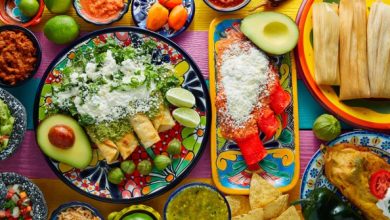“A Culinary Tapestry: Exploring the Diverse and Flavorful Landscape of American Food”
American Food
Introduction:
The cuisine of America is a multifaceted and intricate fabric, influenced by various cultures, regional delicacies, and historical legacies. The food scene in America is a combination of flavors and methods, influenced by anything from early indigenous culinary traditions to immigrant waves that have formed American palates. This article will examine the many facets of American cuisine, including its famous dishes, regional differences, historical foundations, and changing trends that shape this gastronomic adventure.
Historical Roots: Indigenous and Colonial Influences
The culinary customs of the indigenous peoples who lived in the area long before European invaders arrived form the basis of American cuisine. Native American tribes farmed a range of crops, including squash, beans, and corn—collectively referred to as the “Three Sisters.” Many traditional meals that highlighted the value of seasonal dining and sustainable agriculture were based on these crops.
Iconic American Dishes: A Culinary Mosaic
The classic meals that have come to represent the culinary character of the country may be used to trace the growth of American cuisine.
- Hamburgers and Hot Dogs: In the early 20th century, hamburgers and hot dogs became the classic picnic food of the United States. These portable treats swiftly established themselves as mainstays at family get-togethers, ball games, and backyard barbecues, embodying the essence of informal and shared meals.
- Thanksgiving Feast: Thanksgiving is a distinctly American event known for its enormous spread that includes pumpkin pie, cranberry sauce, stuffing, and roast turkey. This yearly event honors the agricultural abundance of the American countryside as well as historical customs.
- Southern Comfort Food: With delicacies like grits, cornbread, collard greens, and fried chicken, the American South has a rich culinary history. Deeply rooted in African, European, and Native American culinary customs, Southern comfort food is praised for its robust tastes and deeply fulfilling quality.
Regional Variations: Culinary Diversity Across the Nation
The gastronomic variety of the United States is a reflection of its size, with each area offering its own distinctive flavors and delicacies.
- Cajun and Creole Cuisine: The unique Cajun and Creole cuisines of Louisiana are well-known. Beignets, gumbo, and jambalaya highlight the Gulf Coast’s characteristics by fusing Spanish, French, and African cuisines.
- Pacific Northwest Seafood: Seafood is abundant in the Pacific Northwest, which is well celebrated for it. Dishes that celebrate the area’s marine heritage heavily incorporate salmon, Dungeness crab, and oysters.
- Midwestern Meat and Potatoes: Hearty beef and potato meals are frequently linked to the Midwest. Famous foods like Kansas City barbecue, Chicago-style deep-dish pizza, and traditional meatloaf showcase the Midwest’s abundance in agriculture.


Culinary Influences of Immigration: A Melting Pot of Flavors
The history of American cuisine is inextricably linked to the migratory waves that have molded the country. Every immigrant group added to the colorful tapestry of American food by bringing with them their own cooking customs, ingredients, and methods.
- Italian-American Cuisine: American palates were influenced by Italian immigrants, especially in the late 19th and early 20th centuries, who brought dishes like pasta, tomato sauce, and pizza. similar days, similar meals are commonplace in homes all over the nation.
- Chinese-American Cuisine: American food was greatly influenced by Chinese immigrants, who brought with them recipes like egg rolls, General Tso’s chicken, and chop suey. Chinese-American cooking combines regional elements with traditional Chinese tastes.
Evolving Trends in American Food: From Farm-to-Table to Fusion Cuisine
America’s food scene changes along with tastes in cuisine. A number of trends that represent people’s increasing knowledge of sustainability, health consciousness, and demand for novel flavors have surfaced in recent years.
- Farm-to-Table Movement: The farm-to-table movement places a strong emphasis on using seasonal, locally sourced products. In order to highlight the quality and freshness of their ingredients, restaurants all throughout the nation have embraced this trend and established direct ties with nearby farmers.
- Craft Beer and Microbreweries: Microbreweries and craft beer festivals have become essential components of the American culinary scene as the craft beer movement has taken the country by storm. A wide variety of beer types may be produced by experimenting with tastes during small-batch brewing.
Conclusion: A Culinary Kaleidoscope
To sum up, American cuisine is a gastronomic kaleidoscope that captures the intricate blend of the country’s topography, history, and cultural influences. The variety of tastes and meals in America is a monument to the country’s diverse legacy, influenced by both the indigenous culinary traditions and the waves of immigration that have shaped the country’s palette.


The culinary landscape of the United States is always evolving, with innovation, sustainability, and a global outlook driving its evolution. It is nonetheless a vibrant representation of the country’s character. The culinary landscape of the United States is a celebration of the tales, customs, and communities that go into creating the colorful and savory mosaic that is American food, rather than only focusing on what is put on the plate.




